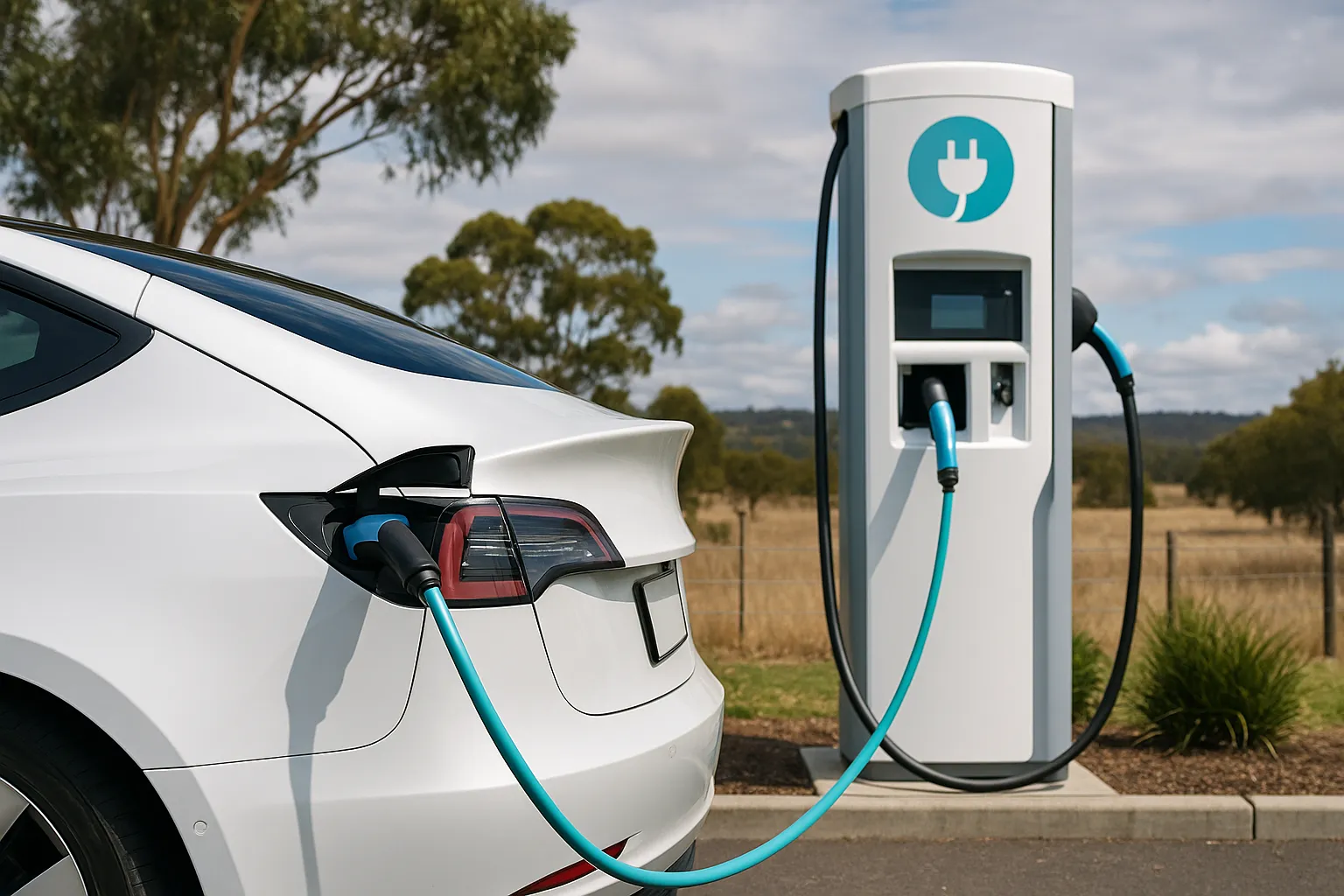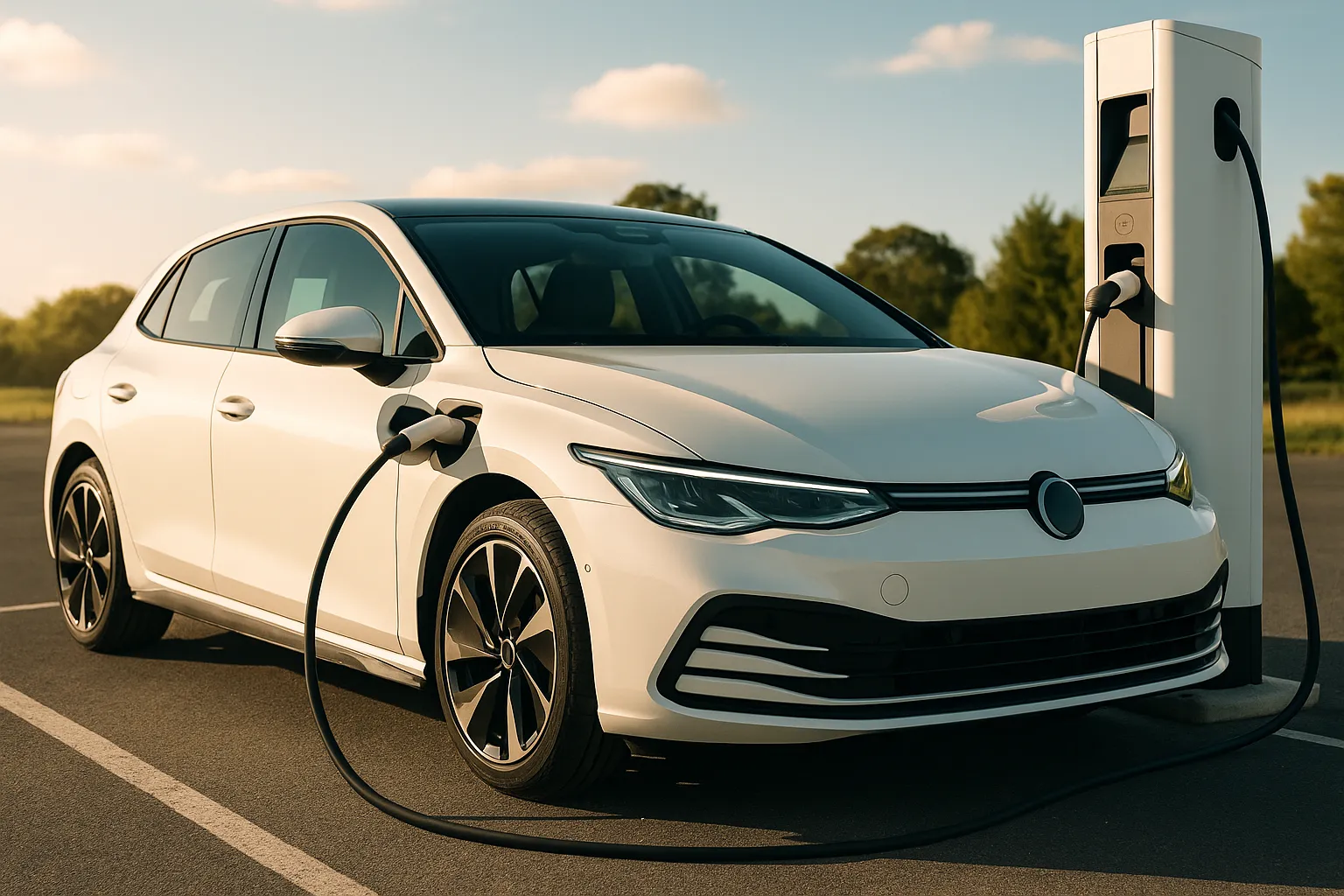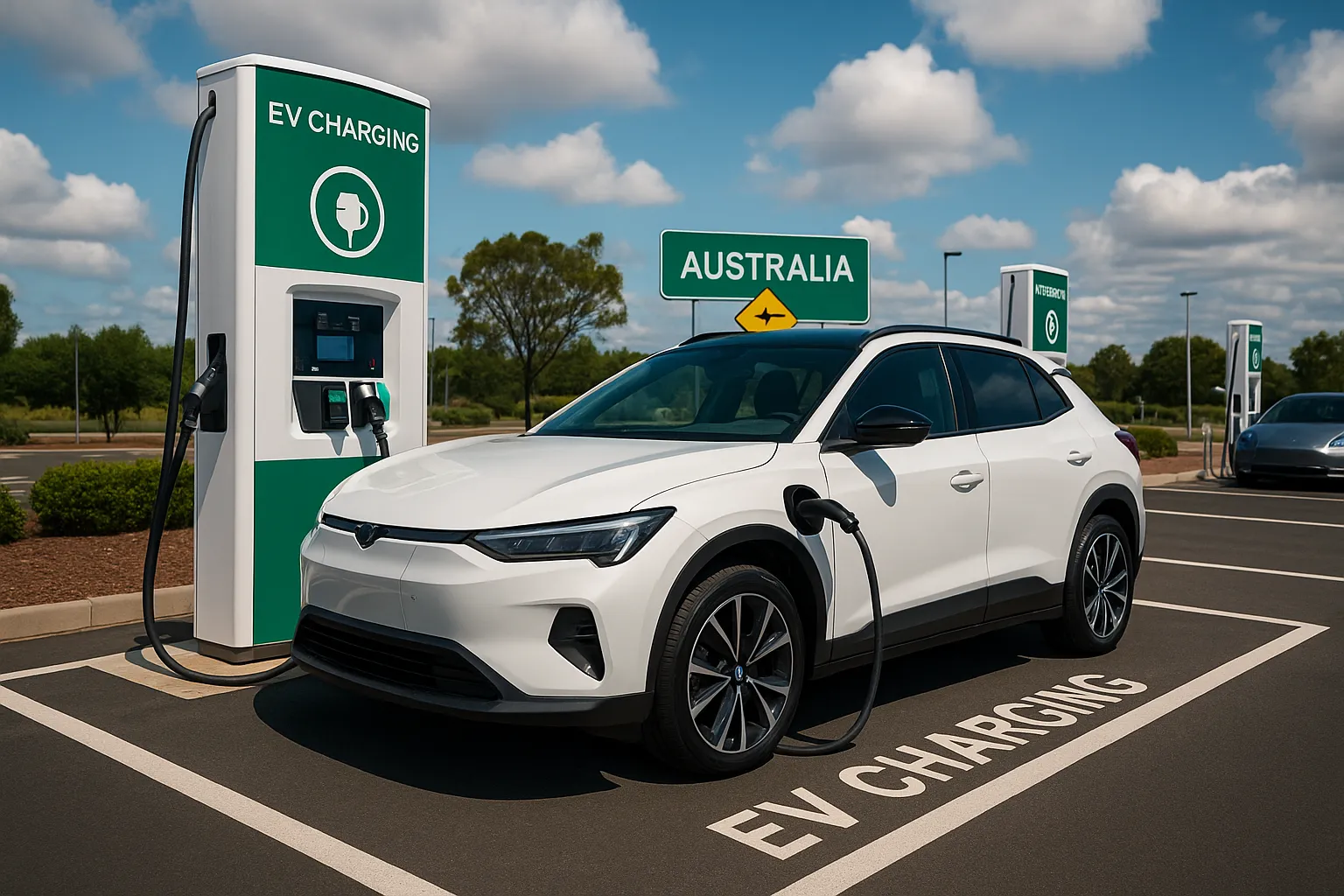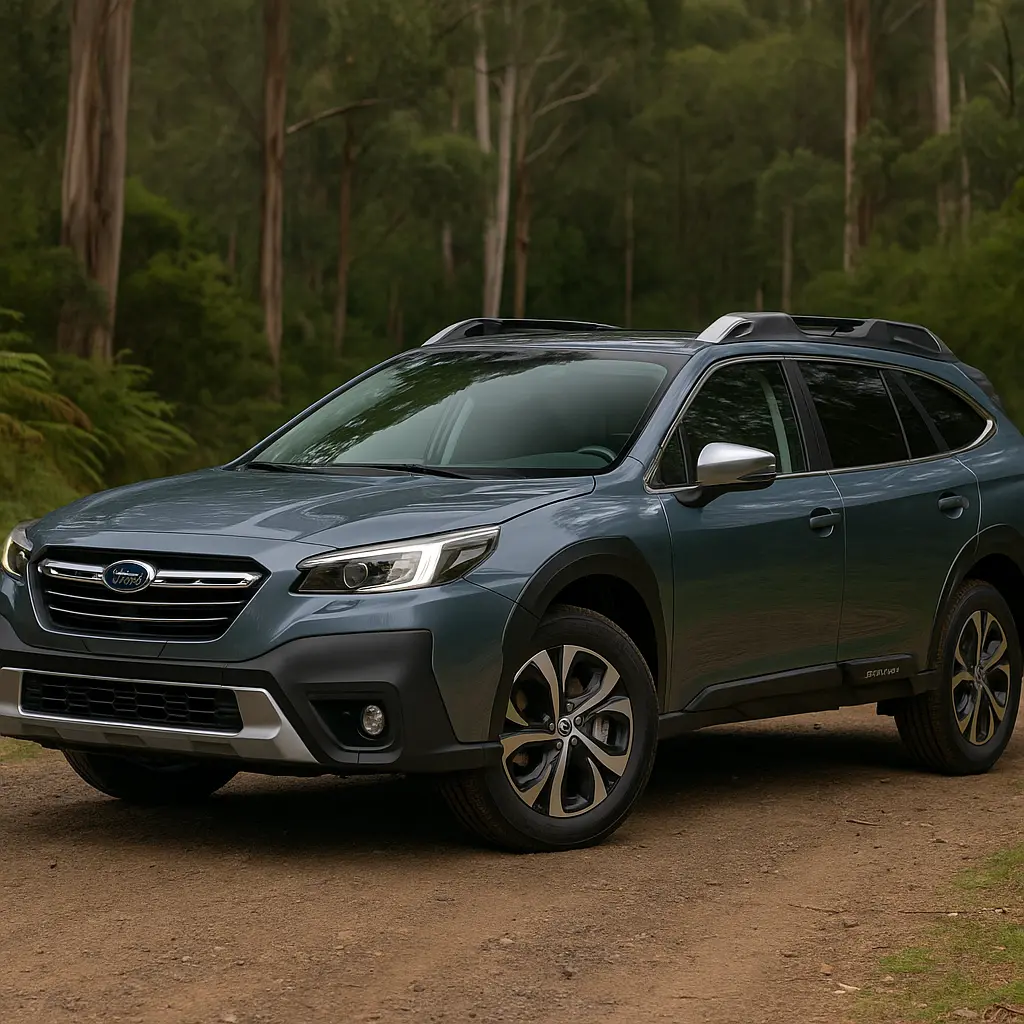The electric vehicle (EV) market in Australia is no longer a fringe trend—it’s a national movement. With EV sales surpassing 15% of new car sales in early 2025, the next critical factor determining EV adoption is infrastructure. That’s right—the charging network.
As range anxiety fades and prices fall, the focus is squarely on whether Australia’s EV charging infrastructure can meet growing demand. This comprehensive guide explores the latest developments in Australia’s charging network, upcoming technologies, and what it means for EV buyers and businesses alike.

1. Australia’s EV Charging Landscape – Where We Stand
1.1 Current Public Charging Network Snapshot
As of early 2025, Australia has:
- 4,000+ public EV charging sites
- Over 8,000 charging plugs
- A rapidly growing number of DC fast chargers, including ultra-rapid 350kW options
Cities like Sydney, Melbourne, Brisbane, and Perth are now better equipped, with high-density charging locations at shopping centres, car parks, and petrol station chains like Ampol and BP Pulse.
1.2 Private and Residential Charging Surge
Over 70% of EV owners charge at home. That number is expected to rise with more affordable and smart Level 2 wall boxes, aided by state and federal incentives in 2025.
2. Key Changes in 2025 – What’s New for EV Charging?
2.1 Federal EV Infrastructure Expansion Plan
The Australian Government, under its National Electric Vehicle Strategy, has committed over $500 million toward:
- Building new ultra-fast charging highways (every 100km on major roads)
- Expanding city charging hubs
- Rolling out rural and regional chargers
- Supporting local councils with EV infrastructure grants
2.2 Ampol, Evie, and Tesla Supercharger Expansion
Private operators are investing heavily:
- Ampol aims to install more than 350 ultra-fast chargers by late 2025.
- Evie Networks is expanding its network with government co-funding.
- Tesla Supercharger network is opening to non-Tesla vehicles at more sites.
This cooperation between private and public sectors is reducing infrastructure gaps.
3. Faster Charging – A Leap in Speed and Accessibility
3.1 The Rise of 350kW Chargers
Older 50kW and 150kW stations are now being supplemented or replaced by ultra-fast 350kW chargers, capable of adding 300km of range in 10–15 minutes.
Notable locations:
- Melbourne to Sydney corridor
- Perth to Margaret River highway
- Brisbane to Sunshine Coast rest stops
3.2 Plug & Charge Tech for Seamless Experience
In 2025, Plug & Charge is finally becoming mainstream in Australia. This feature automatically authenticates your EV and bills your account as soon as you plug in—no apps or cards needed.
It’s supported on newer EV models like:
- Hyundai Ioniq 6
- BMW iX
- Tesla Model Y
- Polestar 2
- Kia EV6 GT
4. Home Charging Revolution – Smarter, Cheaper, Greener
4.1 Smart Wall Boxes
New-generation wall boxes in 2025 support:
- Dynamic load balancing
- Off-peak scheduling
- Integration with solar and battery systems
Popular models: Zappi, Tesla Wall Connector (Gen 3), and Wallbox Pulsar Max.
4.2 State Incentives & Rebates
As of mid-2025:
- Victoria and NSW offer up to $1,000 rebates for EV home charger installations.
- South Australia provides additional subsidies for solar-linked EV charging systems.
These incentives are driving adoption in suburban and rural households.
5. Charging at Work & Apartments – Closing the Gap
5.1 Strata Law Reforms for Apartments
New building codes now mandate EV-ready wiring in all new apartment blocks across NSW, ACT, and VIC. Existing apartment dwellers can access grants to install shared wall boxes.
5.2 Workplace Charging Integration
Companies like Atlassian, Telstra, and Woolworths have rolled out employee EV charging programs, providing:
- Free or discounted charging
- Reserved EV parking bays
- Smart energy management to reduce grid stress
6. Charging Infrastructure in Rural and Remote Australia
6.1 Bridging the Regional Divide
To ensure inclusivity, the Federal Government is funding rural DC charging stations, especially across:
- Outback QLD and NT
- Western NSW
- WA’s southern coast and Pilbara region
The target: no EV driver should be more than 200km from a charger, even in remote areas.
6.2 Charging at Tourist Hotspots
Popular locations like:
- Uluru
- Great Ocean Road
- Byron Bay
- Kakadu
…are receiving dedicated EV charging upgrades with solar-powered off-grid stations.
7. Vehicle-to-Grid (V2G) and Bidirectional Charging – Coming Soon
7.1 What is V2G and Why It Matters
V2G allows your EV to send electricity back to the grid during peak hours, providing grid stability and potentially earning the owner money.
It’s being trialed in SA and VIC, especially with:
- Nissan Leaf
- Mitsubishi Outlander PHEV
- BYD Seal (2025 model)
7.2 Home Energy Ecosystems
In 2025, more Aussie households are using EVs like mobile batteries:
- Charging with solar
- Supplying home power at night
- Selling excess to the grid
It’s an exciting shift turning cars into energy assets.
8. Interoperability & Payment Systems – Getting Simpler
8.1 Unified Payment Apps
Services like Chargefox, Evie, and Tesla now support multi-network roaming, allowing users to:
- See charger availability across platforms
- Pay from one central app
- Track charging costs in real time
8.2 Credit Card & Tap Payment Rollout
Major stations are integrating tap-and-go credit card payment options. This eliminates the need for apps, benefiting tourists and occasional EV users.
9. Government Policy, Targets, and Investments
9.1 Federal & State Targets for 2025–2030
- Federal Goal: 3.8 million EVs on Aussie roads by 2030
- ACT to phase out petrol/diesel car sales by 2035
- NSW & VIC offering tax breaks and stamp duty exemptions
These targets are backed by strong infrastructure investments.
9.2 Fuel Efficiency Standards Linked to Charging Expansion
Australia’s 2025 fuel efficiency standards penalise automakers for selling inefficient vehicles. To hit emissions targets, brands must sell more EVs—and governments must ensure chargers are available to support them.
10. Automaker and Dealer Role in Infrastructure
10.1 EV Brands Building Their Own Networks
Manufacturers are contributing:
- Tesla: Expanding Superchargers (now open to all)
- BYD: Partnering with local energy providers
- Mercedes-Benz: Premium charging hubs with lounges and amenities
10.2 Dealerships Offering Charging as Part of Sale
Some brands now include free wall box + install in EV purchase packages, while others offer discounted charging credit with Chargefox or Evie.
11. Challenges Still to Solve
Despite progress, Australia faces hurdles:
- Grid capacity issues in older suburbs
- Charger vandalism and maintenance gaps
- Lack of public awareness of charging etiquette
- Apartment retrofitting costs remain high
These are actively being addressed through state grants and tech solutions.
12. Future-Proofing EV Charging – What’s Next?
12.1 Wireless Charging Trials
Wireless EV charging pads are being tested in:
- Sydney CBD
- University campuses
- Corporate fleets
This tech could enable hands-free, seamless charging, especially for rideshare and fleet vehicles.
12.2 Renewable Energy-Powered Chargers
More public stations now integrate solar and wind, helping EVs truly go green. Brands like Jolt and Tesla V4 Superchargers lead this charge.
12.3 AI and Smart Grid Integration
Next-gen chargers use AI to:
- Predict traffic patterns
- Adjust pricing based on grid demand
Schedule slow charging overnight for grid efficiency

Conclusion: The EV Charging Future Looks Bright
Australia’s 2025 EV charging infrastructure is fast catching up with global benchmarks. Whether you're planning a long road trip, switching to a greener ride, or charging at your apartment, the infrastructure is more robust, accessible, and smarter than ever.
With strong government backing, rapid technological adoption, and increased private investment, Australia is on a clear trajectory to becoming a fully EV-ready nation.
Leave a comment
Your email address will not be published. Required fields are marked *




















